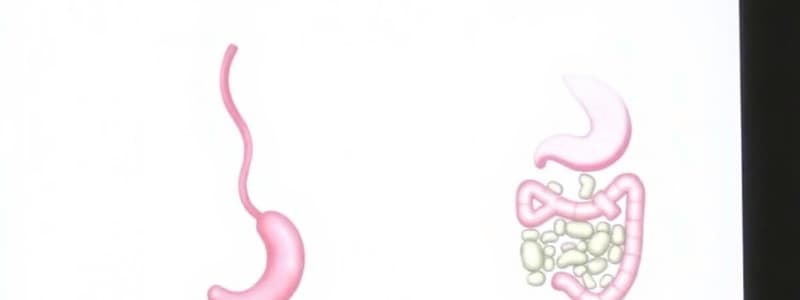Podcast
Questions and Answers
Which enzyme is NOT involved in carbohydrate digestion?
Which enzyme is NOT involved in carbohydrate digestion?
- Sucrase
- Aminopeptidase (correct)
- Lactase
- Isomaltase
What is the primary site of absorption for monosaccharides?
What is the primary site of absorption for monosaccharides?
- Large intestine
- Stomach
- Mouth
- Small intestine (correct)
What type of transport mechanism is used for the entry of monosaccharides into enterocytes?
What type of transport mechanism is used for the entry of monosaccharides into enterocytes?
- Simple diffusion
- Active transport
- Na+/glucose co-transport (correct)
- Facilitated diffusion
What are the products of carbohydrate digestion?
What are the products of carbohydrate digestion?
What is the role of the villus in the intestine?
What is the role of the villus in the intestine?
How is protein primarily absorbed in the enterocyte?
How is protein primarily absorbed in the enterocyte?
Which kind of diffusion is used for the absorption of monosaccharides?
Which kind of diffusion is used for the absorption of monosaccharides?
Which of the following best describes the brush border in the intestine?
Which of the following best describes the brush border in the intestine?
Which enzyme is responsible for the endopeptidase action during protein digestion in the stomach?
Which enzyme is responsible for the endopeptidase action during protein digestion in the stomach?
What is the primary site of carbohydrate digestion?
What is the primary site of carbohydrate digestion?
Which pancreatic enzyme is responsible for further carbohydrate digestion in the small intestine?
Which pancreatic enzyme is responsible for further carbohydrate digestion in the small intestine?
What type of enzyme is carboxypeptidase?
What type of enzyme is carboxypeptidase?
What are the primary products of protein digestion?
What are the primary products of protein digestion?
What is the cleavage specificity of trypsin during protein digestion?
What is the cleavage specificity of trypsin during protein digestion?
What percentage of starch is typically broken down in the mouth?
What percentage of starch is typically broken down in the mouth?
Which enzyme hydrolyzes lactose into glucose and galactose?
Which enzyme hydrolyzes lactose into glucose and galactose?
What type of linkages does pancreatic alpha-amylase act upon?
What type of linkages does pancreatic alpha-amylase act upon?
Which of the following enzymes is NOT involved in carbohydrate digestion?
Which of the following enzymes is NOT involved in carbohydrate digestion?
In which location does no carbohydrate digestion occur?
In which location does no carbohydrate digestion occur?
What type of enzyme is chymotrypsin classified as?
What type of enzyme is chymotrypsin classified as?
What is the role of brush border enzymes in carbohydrate digestion?
What is the role of brush border enzymes in carbohydrate digestion?
Which of the following statements about proteolytic enzymes is correct?
Which of the following statements about proteolytic enzymes is correct?
Which enzymes are primarily responsible for digesting carbohydrates at the intestinal brush border?
Which enzymes are primarily responsible for digesting carbohydrates at the intestinal brush border?
What is the function of the Na+/glucose co-transporter (SGLT1) in the absorption of monosaccharides?
What is the function of the Na+/glucose co-transporter (SGLT1) in the absorption of monosaccharides?
Which of the following best describes the absorption of proteins in enterocytes?
Which of the following best describes the absorption of proteins in enterocytes?
What mechanism primarily drives the transport of monosaccharides into enterocytes?
What mechanism primarily drives the transport of monosaccharides into enterocytes?
Which characteristic of enterocytes enhances their ability to absorb nutrients?
Which characteristic of enterocytes enhances their ability to absorb nutrients?
Which of the following statements is true regarding the absorption mechanisms in the small intestine?
Which of the following statements is true regarding the absorption mechanisms in the small intestine?
What is a primary role of the brush border enzymes in intestinal digestion?
What is a primary role of the brush border enzymes in intestinal digestion?
Which of the following correctly describes a feature of epithelial cells in the intestine?
Which of the following correctly describes a feature of epithelial cells in the intestine?
Which statement about the enzyme pepsin is true?
Which statement about the enzyme pepsin is true?
What products are formed from the cleavage activity of carboxypeptidase A?
What products are formed from the cleavage activity of carboxypeptidase A?
Which enzyme acts on terminal glycosidic bonds in carbohydrates?
Which enzyme acts on terminal glycosidic bonds in carbohydrates?
Which is true regarding the digestion of carbohydrates in the stomach?
Which is true regarding the digestion of carbohydrates in the stomach?
How does trypsin function during protein digestion?
How does trypsin function during protein digestion?
What is the main action of the enzyme chymotrypsin in protein digestion?
What is the main action of the enzyme chymotrypsin in protein digestion?
Which carbohydrate processing enzyme is secreted by the pancreas?
Which carbohydrate processing enzyme is secreted by the pancreas?
In what manner do brush border enzymes assist carbohydrate digestion?
In what manner do brush border enzymes assist carbohydrate digestion?
Which products result from the action of pancreatic a-amylase?
Which products result from the action of pancreatic a-amylase?
Which component is NOT a product of protein digestion?
Which component is NOT a product of protein digestion?
Which of the following is a role of salivary amylase?
Which of the following is a role of salivary amylase?
What is the primary cleavage specificity of elastase?
What is the primary cleavage specificity of elastase?
Which enzyme is released as a zymogen and must be activated for function?
Which enzyme is released as a zymogen and must be activated for function?
Flashcards are hidden until you start studying
Study Notes
Protein Digestion
- Protein digestion begins in the stomach and continues in the small intestine.
- Pepsin is a protease enzyme released by the stomach's chief cells in the form of pepsinogen.
- Pepsinogen is activated by Hydrochloric acid (HCl) to become active pepsin.
- Pepsin is an endopeptidase that breaks down proteins into smaller polypeptides.
- Small intestine protein digestion involves pancreatic enzymes released as zymogens.
- These zymogens are activated by trypsin, which is itself activated by enteropeptidase.
- Trypsin, chymotrypsin, elastase, and carboxypeptidases are the main enzymes in this process.
- Trypsin, chymotrypsin, and elastase are serine proteases that cleave peptide bonds at specific amino acid residues.
- Carboxypeptidase A and B are metalloproteases (Zn2+ dependent) that remove amino acids from the C-terminus of peptides.
- The products of protein digestion are amino acids, dipeptides, tripeptides, and tetrapeptides.
Carbohydrate Digestion
- Carbohydrate digestion primarily occurs in the mouth and small intestine.
- Salivary amylase, secreted by salivary glands, starts the process by breaking down starch into maltose and dextrins in the mouth.
- Pancreatic alpha amylase continues the digestion in the small intestine.
- Pancreatic alpha-amylase is an endoglycosidase that hydrolyses alpha-1,4 glycosidic bonds in starch, producing maltose, maltotriose, and alpha-limit dextrins.
- Brush border enzymes, including maltase, sucrase, lactase, and trehalase, further break down disaccharides into monosaccharides.
- The final products of carbohydrate digestion are glucose, galactose, and fructose.
Absorption
- Absorption is the process of moving digested nutrients, water, and ions across the intestinal epithelial cells.
- This process mainly takes place in the small intestine.
- The small intestine is lined with villi, which increase the surface area for absorption.
- Enterocytes, the epithelial cells lining the villi, have microvilli that further increase the surface area.
- Absorption mechanisms include passive diffusion, facilitated diffusion, and active transport.
- Amino acids are absorbed into the enterocytes via a co-transporter coupled to the H+ gradient.
- Monosaccharides are absorbed into the enterocytes predominantly by a Na+/glucose co-transporter (SGLT1) and a Na+ independent transporter (GLUT5).
- Amino acids and monosaccharides are then transported across the basolateral membrane of the enterocyte into the interstitial fluid.
- From there, they are transported to the liver via the hepatic portal vein.
Studying That Suits You
Use AI to generate personalized quizzes and flashcards to suit your learning preferences.




